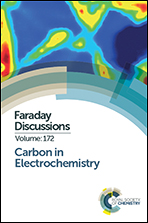Redox-active electrolyte for supercapacitor application
Abstract
This paper reports the electrochemical behaviour of supercapacitor carbon electrodes operating in different aqueous solutions modified by various redox-active species (hydroxybenzenes, bromine derivatives and iodide). Three dihydroxybenzenes with varying stereochemistry, i.e., –OH substitution, have been considered as electrolyte additives (0.38 mol L−1) in acidic, alkaline and neutral solutions. High capacitance values have been obtained, especially for the acidic and alkaline solutions containing 1,4-dihydroxybenzene (hydroquinone). Bromine derivatives of dihydroxybenzenes were also considered as the additive in alkaline solution for use as a supercapacitor electrolyte, and a significant increase in capacitance value was observed. The redox couple investigated next was an iodide/iodine system, where 2 mol L−1 NaI aqueous electrolyte was utilized. In this case, the most promising faradaic contribution during capacitor operation was achieved. In particular, stable capacitance values from 300–400 F g−1 have been confirmed by long-term galvanostatic cycling (over 100 000 cycles), cycling voltammetry and floating. The mechanism of pseudocapacitance phenomena was discussed and supported by electrochemical and physicochemical measurements, e.g., in situ Raman spectroscopy.
- This article is part of the themed collection: Carbon in Electrochemistry

 Please wait while we load your content...
Please wait while we load your content...